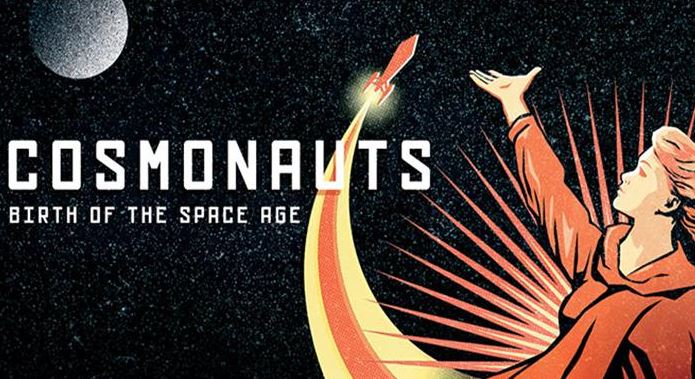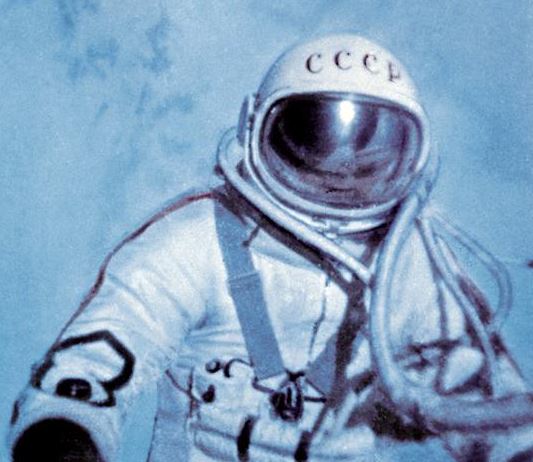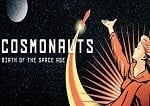Cosmonaut Alexei Leonov, the first human to walk in space fifty years ago, announced the launch of an exhibition at London’s Science Museum of the history of Russia’s Space Programme.
The exhibition – Cosmonauts: Birth of the Space Age – opens on 18th September and is supported by BP, ART RUSSE and the Blavatnik Family Foundation. The Science Museum says tickets are now on sale.
Mr. Leonov’s 12-minute historic spacewalk occurred on 18th March 1965. Scientists at ground control and the rest of the world hailed the event as a remarkable achievement.
 ‘Cosmonauts: Birth of the Space Age’ – opens 18 September 2015. (Image: Science Museum)
‘Cosmonauts: Birth of the Space Age’ – opens 18 September 2015. (Image: Science Museum)
The Museum quotes Mr. Leonov, who said that he and crew mate Pavel Belyayev had faced a series of emergencies during their mission.
After his spacewalk, Leonov battled to get back into the spacecraft. Then the navigation failed and the cosmonauts had to steer the spaceship manually back to Earth. It tumbled violently, exposing the Leonov and Belyayev to ten times the force of gravity.
They landed hundreds of miles off course in the Ural Mountains and had to spend the night in temperatures below -25°C.
Speaking at the Science Museum yesterday, Mr. Leonov said:
“There were many problems during my first flight. Many of those were impossible to test on Earth, for example, how would the space suit react in the vacuum of space?”
“But I had to do it. What I want to say is that even if it’s only a small thing you want to achieve, you still need to make every possible effort and do it thoroughly.”
The exhibition will feature the largest and most significant collection of Russian artefacts and spacecraft ever shown in the United Kingdom.
 Alexei Leonov during the first ever space walk, on March 18, 1965. (Image: Wikipedia)
Alexei Leonov during the first ever space walk, on March 18, 1965. (Image: Wikipedia)
The exhibition tells the incredible story of technological and scientific ingenuity that sparked the space age with a record number of firsts for what was then the Soviet Union.
Visitors in the UK now have the opportunity to get up close to many of the major innovations that made space exploration possible, from the work of Cosmist thinkers at the end of the 19th Century, who first proposed that our destiny lay in space, to the reality of living in space on board the International Space Station and Mir.
The Soviet Union launched Sputnik in 1957, the world’s first artificial satellite. Four years later it sent the first human being into space – Yuri Alekseyevich Gagarin.
Russians long-yearned for space travel
The exhibition explores the science and technology of Russian space travel and its spiritual and cultural context, demonstrating a deep-rooted national longing for space that was shaped by the turbulent first few decades of the 20th century.
The exhibition features Konstantin Tsiolkovsky’s (a rocket pioneer) amazing 1933 drawings of space flight, depicting weightlessness, spacewalks, and life in orbit nearly three decades before it happened.
Sergei Korolev, lead rocket engineer and designer of the artificial satellite Sputnik, insisted it had a shiny appearance, because he was convinced that one day there would be replicas displayed in the world’s major museums.
Within six years of putting the first man in space, the Soviet Union launched the first animal and woman into orbit. London’s exhibition features Vostok-6, the actual capsule that in 1963 carried the first woman to travel into space – Valentina Tereshkova.
Director of the Science Museum, Ian Blatchford, said:
“We are honoured that Alexei Leonov could join us today, fifty years after becoming the first person to walk in space. Cosmonauts is a once-in-a-lifetime exhibition that has taken years of dedication and skill from the Science Museum team to make a reality.”
“The Russian space programme is one of the great intellectual, scientific and engineering successes of the 20th century and I am thrilled that we have been able to bring together such an outstanding collection of Russian space artefacts to celebrate these achievements. I want to thank all our partners and funders who have made this exhibition possible.”
The exhibition also features Russia’s own secretive manned Moon progamme, which only an inner circle of scientists, cosmonauts and politicians knew about until 1989. Visitors can see the the five-metre-tall LK-3 lunar lander.
BP’s CEO Bob Dudley said:
“Cosmonauts tells the story of the Russian space programme as never before – and in doing so it also tells the story of Russia through its history, technology, culture and its people. BP has a long-standing relationship with the Science Museum aimed at increasing public engagement with science and technology.”
“Our support of Cosmonauts is also an extension of BP’s broader efforts in Russia to promote the development of science and engineering as well as excellence in arts and culture.”
The exhibition will run from 18th September 2015 until 3th March 2016.

